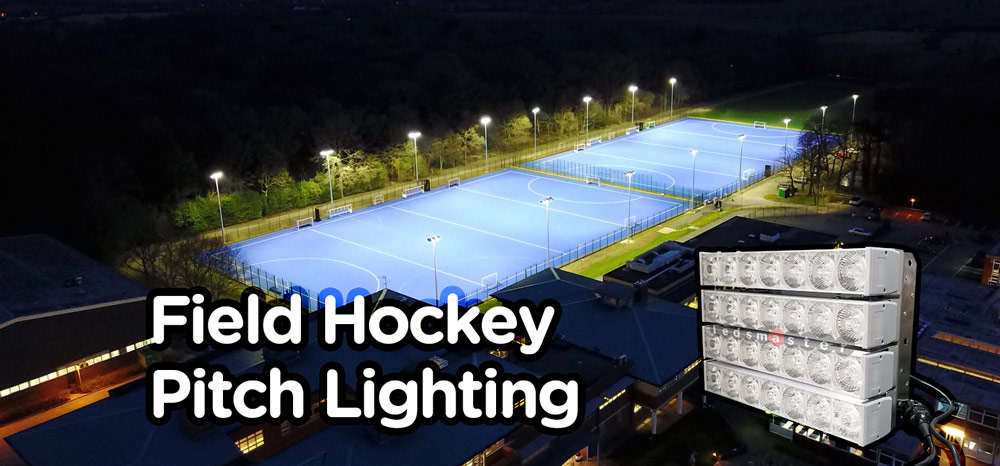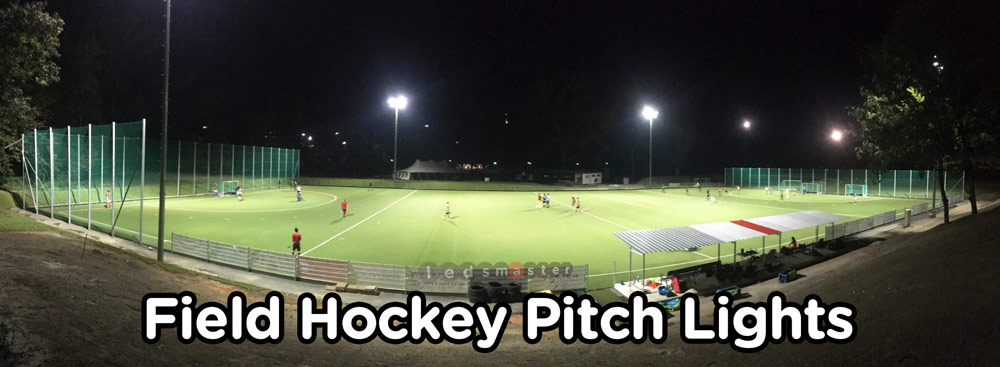Lighting a field hockey pitch is more than just brightening the playing area; it’s about creating an environment that enhances gameplay and viewer experience. Proper design involves balancing lux levels, ensuring uniform illumination, and addressing issues like strobing and light pollution. This guide explores the essential aspects of field hockey pitch lighting, focusing on how to achieve optimal performance and a vibrant atmosphere for players and spectators alike.
Get your complimentary lighting design today
To ensure a smooth continuation of hockey games during nighttime, it’s essential to have adequate field hockey pitch lighting. Given that a standard hockey field measures approximately 91 by 55 meters, lighting such a large area typically requires high-powered outdoor floodlights, ranging from 1500 to 4000 watts. In addition to providing sufficient illumination, the optimal lighting system for hockey fields should be designed to be anti-glare and flicker-free, enhancing visibility for both players and spectators. Let’s explore how to effectively illuminate a hockey stadium or club using LED technology and examine the benefits of upgrading from traditional metal halide, high-pressure sodium (HPS), or mercury vapor lamps to LED lighting.
Table of Contents
ToggleDesigning lighting for a hockey field presents unique challenges compared to other types of commercial lighting. Key factors include:
The required brightness level for hockey field lighting varies depending on the level of competition. For recreational or community-level hockey, the lighting should provide approximately 200 to 300 lux. National tournaments require a higher illumination level, around 500 to 750 lux. For international events such as the Men’s and Women’s Champions Trophy, Commonwealth Games, or World Cup, the field needs up to 1000 to 2000 lux of horizontal illumination.
It’s essential to consider both horizontal and vertical illumination. Horizontal lighting measures the brightness on the field, while vertical lighting illuminates the players’ faces and bodies. Vertical lux levels are crucial for high-definition (FHD) or 4K television broadcasts, as they ensure clear capture of player movements.
Maintaining a balanced ratio of horizontal to vertical lux levels, ideally around 1:1, is challenging but necessary. Our lighting designers use DIALux to create tailored photometric plans for each project, recognizing that every field has unique pole arrangements and lighting needs. Contact us for a free lighting assessment tailored to your specific requirements.

Achieving consistent lighting across a hockey field presents a complex challenge due to the inherent limitations of pole and luminaire placement. Effective uniformity in lighting ensures that there are minimal variations between the brightest and darkest areas of the field, which is crucial for both player performance and audience visibility.
Uniformity is measured on a scale from 0 to 1, with a value of 1 indicating perfect uniformity. For professional matches, a uniformity rating of around 0.7 is typically required. This means the minimum illuminance on the field should be at least 70% of the average illuminance, ensuring that no area is significantly darker than others. Achieving this level of uniformity requires meticulous planning and precise placement of lighting fixtures to minimize shadows and hotspots.
Our approach to providing high-quality lighting solutions involves detailed analysis and advanced design tools like DIALux. This software helps us simulate different lighting scenarios and optimize pole and luminaire arrangements to achieve the best possible uniformity. We tailor our solutions based on specific field dimensions, pole configurations, and lighting requirements. By doing so, we ensure that the lighting system not only meets but exceeds the standard uniformity requirements, delivering a consistent and high-quality playing environment.
Strobing, or flickering, is a significant issue that can adversely affect both players and spectators. This flickering effect can cause eye strain, headaches, and discomfort, and it can also disrupt video recordings by creating visual distortions. Traditional lighting sources such as fluorescent, metal halide, and other gas discharge lamps are often prone to flickering, especially when operating at lower frequencies.
To combat these issues, we provide advanced flicker-free LED lighting solutions. These LEDs are engineered to operate at high frequencies—between 5000 and 6000 Hz—ensuring smooth and stable illumination. This high frequency prevents the rapid on-off cycling that causes flickering, allowing for clear, uninterrupted visual experiences for players and accurate video recordings. Our flicker-free LEDs are designed to handle the fast movements of hockey pucks and sticks, ensuring that every action is captured with sharp clarity and minimal distortion.
When illuminating a large area like a hockey field, high-powered LED lights, ranging from 5000 to 20000 watts, are often required to achieve adequate brightness. However, without proper management, these powerful lights can lead to significant light pollution. Light pollution not only affects the quality of life for nearby residents but can also disrupt local wildlife habitats.
To address this issue, we utilize patented anti-glare lenses that focus light precisely where it is needed. These lenses are designed to minimize light spill and direct the illumination towards the field, reducing light leakage by over 93%. By controlling and concentrating the light, we effectively mitigate the negative impacts of light pollution. This ensures that the surrounding areas remain unaffected, preserving both the environment and the well-being of nearby communities.

If you’re contemplating whether to switch to LED lights or replace existing HID lighting, it’s essential to understand the numerous benefits that LEDs offer. Here’s a comprehensive look at why LED lights are a superior choice for field hockey stadiums:
One of the most compelling reasons to switch to LED lights is their exceptional durability. LED lights significantly outperform traditional halogen bulbs in terms of lifespan. While halogen bulbs typically need to be replaced every few thousand hours, LEDs boast a lifespan that is approximately ten times longer. Our LED sports lights have an impressive lifespan of up to 80,000 hours, equating to over 30 years of use under normal conditions. This longevity translates into substantial cost savings over time, not only in terms of purchasing new lights but also in reduced installation and maintenance costs.
Moreover, LEDs are built to withstand harsher conditions compared to their halogen counterparts. With an IP66 rating, our LED lights are designed to be fully dust-tight and protected against powerful water jets, making them highly suitable for outdoor high mast lighting. They perform reliably even in extreme weather conditions such as heavy rain, snow, or high winds, ensuring consistent illumination throughout their operational life.
LED lights offer superior energy efficiency compared to traditional lighting technologies. The luminous efficacy of lighting devices, which measures how efficiently a light source converts electrical power into visible light, varies between different types of lights. Our LED lights provide between 130 and 140 lumens per watt, a significant improvement over halogen bulbs, which offer only 10 to 15 lumens per watt. Metal halide lights are somewhat better, providing 75 to 90 lumens per watt, but still fall short compared to LEDs.
This high energy efficiency means that LEDs require less power to produce the same amount of light, leading to lower electricity bills and reduced environmental impact. Although the initial cost of LED lights may be higher than conventional lighting options, the long-term savings on energy and maintenance make it a worthwhile investment. The efficiency of LEDs not only benefits your budget but also contributes to a more sustainable and eco-friendly operation.
One of the standout features of LED lighting is its versatility. Thanks to our dedicated R&D team and in-house manufacturing capabilities, we can offer customized LED flood lights tailored to your specific needs. Whether it’s adjusting the structural design, power, beam angle, lens, or driver, we can create a lighting solution that perfectly matches the unique requirements of your field hockey stadium.
By gathering detailed information such as ground lux levels, uniformity requirements, pole height, and the number of poles, we deliver bespoke lighting solutions designed to optimize performance. This flexibility allows us to address various scenarios and ensure that your lighting system provides optimal illumination and meets all necessary standards. Customization also ensures that the lighting not only enhances the visibility for players and spectators but also integrates seamlessly with your existing infrastructure.
Switching to LED lights for your field hockey stadium is a strategic decision that offers long-term benefits in terms of durability, energy efficiency, and flexibility. By making this upgrade, you’ll enjoy enhanced performance and cost savings while contributing to a more sustainable future.
The transition to LED lights offers significant advantages, including superior durability, enhanced energy efficiency, and greater flexibility in customization. LEDs not only extend the lifespan of lighting fixtures but also reduce energy consumption and operational costs, while their customizable features ensure optimal performance tailored to specific needs. Embracing LED technology provides a reliable and sustainable solution, enhancing the playing experience and contributing to long-term savings and environmental benefits.